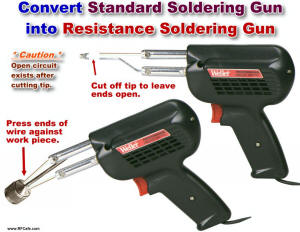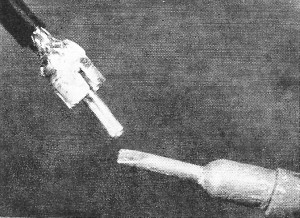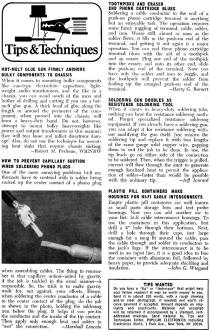|
December 1973 Popular Electronics
 Table of Contents
Table of Contents
Wax nostalgic about and learn from the history of early electronics. See articles
from
Popular Electronics,
published October 1954 - April 1985. All copyrights are hereby acknowledged.
|
Here are a few good
soldering tips that appeared in a 1973 issue of Popular Electronics magazine.
One suggests using hot melt glue to hold components and cables in place both for
soldering and just to keep them from moving during normal use. Another describes
how to turn a standard pistol type soldering gun into a resistance soldering tool.
It actually works pretty well for soldering sheet brass and copper and for high
mass items like connector shells, but do keep
in mind that there is a live voltage* between the two sections of wire when they
are not making contact with the work piece. There's also a recommended method of
soldering stranded or braided wire like coaxial cable shielding without having so
much of the solder wick into the braid beyond where you want it (another way is
to clamp a heatsink on the braid to prevent excess wicking). I posted an image file
of the entire page to you can see other non-soldering related tips.
* My Craftsman Heavy Duty 230/150 Watt Dual Heat Solder Gun (not made
anymore) measures 0.996 VAC/0.825 VAC, respectively, at the ends without the tip
installed.
Tips & Techniques: Soldering Gun Doubles as Resistance Soldering
Tool


Convert your standard soldering gun to a resistance soldering
tool.
Weller Soldering Gun

Prevent solder from wicking into wire braid or strands.
Soldering Gun Doubles as Resistance Soldering Tool
When it comes to heavy-duty soldering jobs, nothing can beat the resistance soldering
method. Forget specialized resistance soldering equipment. If you already have a
soldering gun, you can adapt it for resistance soldering without modifying the gun
itself. Just remove the soldering tip and replace it with two lengths of the same
gauge solid copper wire, gapping them to suit the job to be done. In use, the tip
leads go on either side of the connection to be soldered. Then, when the trigger
is pulled, current will flow through the joint to generate enough localized heat
to permit the application of solder - faster than would be possible with the ordinary
tip. - Jeff Jourard
 How to Prevent Capillary Suction When Soldering
Phono Plugs How to Prevent Capillary Suction When Soldering
Phono Plugs
One of the more annoying problems hi-fi enthusiasts have to contend with is solder
being sucked up the center contact of a phono plug when assembling cables. The thing
to remember is that capillary action - aided by gravity if the job is tackled in
the usual manner - is responsible. So, the trick is to make gravity work for, not
against, your efforts. Hence, when soldering the center conductor of a cable to
the center contact of the plug, do the job as shown in the photo, holding the soldering
iron below the plug. It helps if you pre-tin the conductor and the inside of the
tip contact. Then apply only enough heat and solder to "wet" the connection. - Marshall
Lincoln
Hot-Melt Glue Gun Firmly Anchors Bulky Components to Chassis
When it comes to mounting bulky components like can-type electrolytic capacitors,
light-weight audio transformers, and the like in a chassis, you can avoid much of
the mess and bother of drilling and cutting if you use a hot-melt glue gun. A thick
bead of glue along the length or around the perimeter of the component, when pressed
into the chassis, will form a heavy-duty bond. Do not, however, attempt to mount
bulky heavyweights like power and output transformers in this manner; they will
tear loose and inflict disastrous damage. Also, do hot use this technique for mounting
heat sinks that require chassis sinking. - Robert M. Perlman, WB2VRW
Posted November 27, 2019
|













